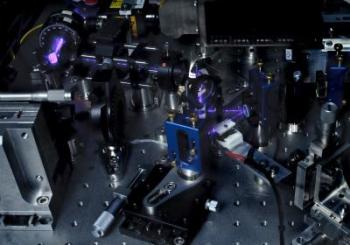Apr 16 2013
A team led by the Austrian physicist Anton Zeilinger has now carried out an experiment with photons, in which they have closed an important loophole. The researchers have thus provided the most complete experimental proof that the quantum world is in conflict with our everyday experience. The results of this study appear this week in the renowned journal Nature (Advance Online Publication/AOP).
 This is Lab IQOQI. Credit: Jacqueline Godany
This is Lab IQOQI. Credit: Jacqueline Godany
When we observe an object, we make a number of intuitive assumptions, among them that the unique properties of the object have been determined prior to the observation and that these properties are independent of the state of other, distant objects.
In everyday life, these assumptions are fully justified, but things are different at the quantum level. In the past 30 years, a number of experiments have shown that the behaviour of quantum particles – such as atoms, electrons or photons – can be in conflict with our basic intuition. However, these experiments have never delivered definite answers. Each previous experiment has left open the possibility, at least in principle, that the observed particles 'exploited' a weakness of the experimental setup.
Quantum physics is an exquisitely precise tool for understanding the world around us at a very fundamental level. At the same time, it is a basis for modern technology: semiconductors (and therefore computers), lasers, MRI scanners, and numerous other devices are based on quantum-physical effects. However, even after more than a century of intensive research, fundamental aspects of quantum theory are not yet fully understood. On a regular basis, laboratories worldwide report results that seem at odds with our everyday intuition but that can be explained within the framework of quantum theory.
On the trail of the quantum entanglement mystery
The physicists in Vienna report not a new effect, but a deep investigation into one of the most fundamental phenomena of quantum physics, known as 'entanglement.' The effect of quantum entanglement is amazing: when measuring a quantum object that has an entangled partner, the state of the one particle depends on measurements performed on the partner. Quantum theory describes entanglement as independent of any physical separation between the particles. That is, entanglement should also be observed when the two particles are sufficiently far apart from each other that, even in principle, no information can be exchanged between them (the speed of communication is fundamentally limited by the speed of light). Testing such predictions regarding the correlations between entangled quantum particles is, however, a major experimental challenge.
Towards a definitive answer
The young academics in Anton Zeilinger's group including Marissa Giustina, Alexandra Mech, Rupert Ursin, Sven Ramelow and Bernhard Wittmann, in an international collaboration with the National Institute of Standards and Technology/NIST (USA), the Physikalisch-Technische Bundesanstalt (Germany), and the Max-Planck-Institute of Quantum Optics (Germany), have now achieved an important step towards delivering definitive experimental evidence that quantum particles can indeed do things that classical physics does not allow them to do. For their experiment, the team built one of the best sources for entangled photon pairs worldwide and employed highly efficient photon detectors designed by experts at NIST. These technological advances together with a suitable measurement protocol enabled the researchers to detect entangled photons with unprecedented efficiency. In a nutshell: "Our photons can no longer duck out of being measured," says Zeilinger.
This kind of tight monitoring is important as it closes an important loophole. In previous experiments on photons, there has always been the possibility that although the measured photons do violate the laws of classical physics, such non-classical behaviour would not have been observed if all photons involved in the experiment could have been measured. In the new experiment, this loophole is now closed. "Perhaps the greatest weakness of photons as a platform for quantum experiments is their vulnerability to loss – but we have just demonstrated that this weakness need not be prohibitive," explains Marissa Giustina, lead author of the paper.
Now one last step
Although the new experiment makes photons the first quantum particles for which, in several separate experiments, every possible loophole has been closed, the grand finale is yet to come, namely, a single experiment in which the photons are deprived of all possibilities of displaying their counterintuitive behaviour through means of classical physics. Such an experiment would also be of fundamental significance for an important practical application: 'quantum cryptography,' which relies on quantum mechanical principles and is considered to be absolutely secure against eavesdropping. Eavesdropping is still theoretically possible, however, as long as there are loopholes. Only when all of these are closed is a completely secure exchange of messages possible.
An experiment without any loopholes, says Zeilinger, "is a big challenge, which attracts groups worldwide." These experiments are not limited to photons, but also involve atoms, electrons, and other systems that display quantum mechanical behaviour.
The experiment of the Austrian physicists highlights the photons' potential. Thanks to these latest advances, the photon is running out of places to hide, and quantum physicists are closer than ever to conclusive experimental proof that quantum physics defies our intuition and everyday experience to the degree suggested by research of the past decades.